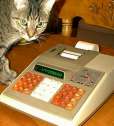Aurora DS17
| Datasheet legend
Ab/c:
Fractions calculation
AC: Alternating current BaseN: Number base calculations Card: Magnetic card storage Cmem: Continuous memory Cond: Conditional execution Const: Scientific constants Cplx: Complex number arithmetic DC: Direct current Eqlib: Equation library Exp: Exponential/log functions Fin: Financial functions Grph: Graphing capability Hyp: Hyperbolic functions Ind: Indirect addressing Intg: Numerical integration Jump: Unconditional jump (GOTO) Lbl: Program labels LCD: Liquid Crystal Display LED: Light-Emitting Diode Li-ion: Li-ion rechargeable battery Lreg: Linear regression (2-var. stats) mA: Milliamperes of current Mtrx: Matrix support NiCd: Nickel-Cadmium recharg. batt. NiMH: Nickel-metal-hydrite rech. batt. Prnt: Printer RTC: Real-time clock Sdev: Standard deviation (1-var. stats) Solv: Equation solver Subr: Subroutine call capability Symb: Symbolic computing Tape: Magnetic tape storage Trig: Trigonometric functions Units: Unit conversions VAC: Volts AC VDC: Volts DC |
| ||||||||||||||||||||||||||||||||||||||||||||||||||||||||
Aurora DS17
 Here's a most unusual calculator that I just received from a fellow collector (thanks, Dennis!) It is just one of those plain vanilla 40-step programmables on the inside, but on the outside! "Hybrid keyboard"? Just who on Earth comes up with an idea like this?
Here's a most unusual calculator that I just received from a fellow collector (thanks, Dennis!) It is just one of those plain vanilla 40-step programmables on the inside, but on the outside! "Hybrid keyboard"? Just who on Earth comes up with an idea like this?
And it's not a very well implemented idea, unfortunately. The lower half of the keyboard is attached to the main PCB using a dreaded heat seal ribbon. Unlike that heat seal that connects the display, which is thankfully still functional, this one isn't; much of the lower half of the keyboard is dead, or nearly so, and my attempts to repair the heat seal connections were not particularly successful. Maybe one day I'll try and replace it with soldered wire (though I'm worried that the flexible circuit that is part of the keyboard may not be solderable); until then, at least the π button works, so I was able to take a scan of the calculator just the way I like it!

